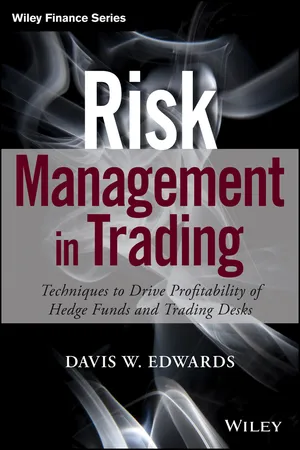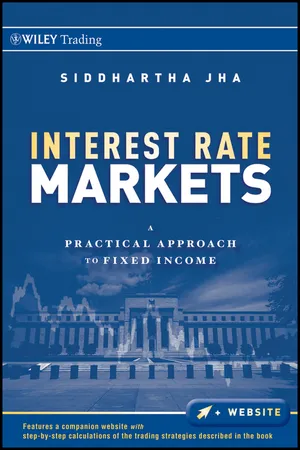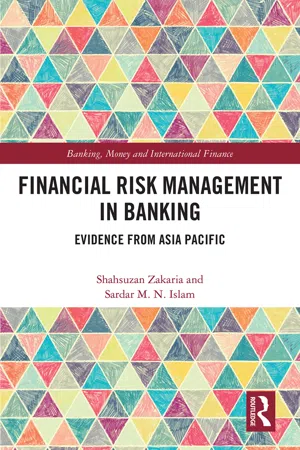Business
Hedge Ratio
The hedge ratio is a measure used to determine the amount of hedging needed to offset the risk of an investment. It involves calculating the ratio of the value of the investment being hedged to the value of the hedging instrument. This helps businesses manage their exposure to price fluctuations and minimize potential losses.
Written by Perlego with AI-assistance
Related key terms
Related key terms
1 of 4
Related key terms
1 of 3
4 Key excerpts on "Hedge Ratio"
- eBook - ePub
Multi-Asset Risk Modeling
Techniques for a Global Economy in an Electronic and Algorithmic Trading Era
- Morton Glantz, Robert Kissell(Authors)
- 2013(Publication Date)
- Academic Press(Publisher)
As stated, the Hedge Ratio of a portfolio is defined as the value invested into the hedged position compared to the value of the original portfolio. For example, if the current portfolio has a value of $100 million and the manager hedges the portfolio using $50 million of a futures index, the Hedge Ratio is calculated as:Notice that in this calculation the ratio is not the hedged position divided by total dollar value invested by the manager of $150 million (e.g., $100 million invested in the portfolio plus a $50 million value invested in the futures index equals $150 million). That is, the Hedge Ratio is not $50 million/$150 million=1/3.It is important to distinguish the difference in the Hedge Ratio calculations to ensure proper hedging values and weighting schemes. Different authors and different practitioners may denote the Hedge Ratio using different denominators. That is, depending upon the context of the study, the Hedge Ratio from the previous example may be stated as h=1/2 or h=1/3. While the definition we provided is the true and universally accepted definition, this, unfortunately, is not used consistently throughout the industry. Analysts are always encouraged to verify the definition being used by the researcher.The optimal Hedge Ratio is defined as the proportion of portfolio dollars to invest into the hedge portfolio in order to best minimize total portfolio risk. For example, a Hedge Ratio of indicates that the dollar value of the hedge portfolio must be two times the dollar value of the held portfolio, and a Hedge Ratio of indicates that the dollar value of the hedge portfolio must be one-half times the dollar value of the held portfolio.Mathematically, the optimal Hedge Ratio is equal to the negative covariance between the held portfolio and the hedging portfolio divided by the variance of the hedging portfolio. That is: - eBook - ePub
Risk Management in Trading
Techniques to Drive Profitability of Hedge Funds and Trading Desks
- Davis Edwards(Author)
- 2014(Publication Date)
- Wiley(Publisher)
speculative positions. However, the risk of a hedge is identical to a speculative trade—it is only the intent of the trade that is different.In the case of the oil drilling company, the company is giving up potential profits if oil prices rise. If the oil well was purchased based on the belief that prices would rise, locking in current prices might be a bad idea. This problem can be compounded if a lot of money is spent on hedging. Certain financial instruments, like options, cost a tremendous amount of money. Traders have to weigh the benefit of removing uncertainty against the cost of hedging.In addition to its role in trading and risk management, hedging is also an accounting concept. If an investment qualifies as a highly effective hedge for accounting purposes, the hedging company can get beneficial accounting treatment by combining the gains and losses from the hedge and the underlying investment. This is important because hedges often use financial investments subject to mark-to-market rules (like financial futures) to offset a physical obligation (like owning oil in an oil well) which does not need to be marked to market.KEY CONCEPT: HEDGING IS A WAY TO TRANSFER RISK
Hedging is a way to transfer some or all risks from a position to another trader. It has a protective purpose. This is similar to how the term is used in a garden. In gardening, a hedge is a line or wall of closely spaced shrubs and trees. Hedges might be planted around a garden or a house for protection the same way that a wall might be built. In finance, a hedge is also intended to protect something. A hedge is an investment whose purpose is to reduce the uncertainty of another investment (the hedged item) by offsetting potential profits and losses.HOW IS HEDGING USED?
On a trading desk, hedging is used for a variety of purposes. A common example is to reduce uncertainty in an existing line of business. For example, an airline might use hedging to reduce its exposure to jet fuel prices by arranging to buy fuel at fixed prices. In other cases, it means to transfer or offset risk. Hedge funds were originally called hedge funds because they had the ability to take both long and short positions. - eBook - ePub
Interest Rate Markets
A Practical Approach to Fixed Income
- Siddhartha Jha(Author)
- 2011(Publication Date)
- Wiley(Publisher)
Finally, we come to Eurodollar futures, which are futures contracts of a much shorter duration than the other instruments discussed here. Nevertheless, by using strips of Eurodollars, longer-dated assets can be synthetically created, as described earlier. However, the strip limit is five years, and in practice it generally is no more than three years due to liquidity constraints in very long-dated Eurodollar contracts. This means Eurodollar futures are best used for hedging assets with three years or less in maturity. Eurodollars can be considered the atomic-level breakdown of swaps, and so relative value considerations that lead to swaps generally proscribe Eurodollars as well at the shorter end. Therefore, an expectation of wider short-end swap spreads can make either swaps or Eurodollar hedges optimal to use, rather than Treasuries. Between swaps and Eurodollars, though, relative value is rarely a consideration as the markets are very well arbitraged by dealers. Investors wishing to keep the transparency and ease of transaction that an exchange provides tend to prefer Eurodollar hedges; those who need hedges with longer maturities and/or a high level of customization tend to use swaps. Eurodollar futures are also preferred hedges for shorter-term floating rate instruments where cash flows may be irregular or exposed to frequent floating rate reset risk. The atomic-level cash flow hedging provided by Eurodollar futures makes them a preferred hedge in such cases.CALCULATING Hedge RatioSSo far we have discussed the fundamental reasons for hedging and the criteria to use in deciding which product to choose for the optimal hedge. Whichever hedge is chosen, the next step is to calculate the amount of the hedge to trade. This is important since the use of too large or too small a hedge amount can leave the investor with unwanted exposure to the market and lead to higher-than-expected volatility in P/L.We initially consider the case of hedging with a Treasury bond, as the other choices are modest modifications to the general principles presented here. The main principle in hedging interest rate risk is to match the exposure of the asset and hedge security to interest rates. Recall that in Chapter 3 we introduced the concept of duration and the closely related DV01 (modified duration × price) as the P/L sensitivity to a move in interest rates for a unit amount of notional. The basic process of calculating Hedge Ratios—that is, the amount of notional of the hedge per unit notional of the original asset—is to equate DV01s for the total asset position and the hedge position.An example will help clarify. Suppose we own a corporate bond of XYZ corp. with a maturity of 5 years and duration of 4.5. The duration can be calculated using various financial software packages or Microsoft Excel. Let us also assume this bond is trading at a price of $99 (per $100 face value) and that we own $50 million notional of the bond. The four-step process to calculating the Hedge Ratio is: - eBook - ePub
Financial Risk Management in Banking
Evidence from Asia Pacific
- Shahsuzan Zakaria, Sardar Islam(Authors)
- 2019(Publication Date)
- Routledge(Publisher)
Apart from the lack of quality for an effectiveness measurement, the hedge effectiveness measurements are too complex to collectively discuss the potential impact of derivative instruments use in enhancing the safety and soundness of financial institutions. Therefore, the extension of the traditional ratio analysis which is applied in the DOR in hedge effectiveness test permits the incorporation of the simple ratio dimension of performance, using a DEA approach. It thus supports the implementation of the new hedge accounting model, as McConnell (2014) believes that it will better align and reduce inconsistencies between financial accounting and the economics of the related risk management strategy.3.5 Framework for hedge effectiveness in hedge accounting
In the banking environment, derivatives are preferred as a hedging tool to mitigate exposure to risk, including interest rate risk. Finance theory explains that derivative activities are used for hedging strategies. To hedge specific types of risks, the management has to designate a hedging relationship that satisfies the accounting definition of derivatives. Due to this requirement, the hedging relationship measurement depends on hedge effectiveness to highlight the offsetting value of the hedged items. The DOR has been chosen as an approach to an effectiveness test comprising the hedging instrument and hedged items. The effectiveness of a hedging strategy reflects the management’s intent to use the derivative instrument as a financial risk management tool to actually hedge risk exposure. Hence, the involvement of a bank in financial derivatives provides evidence for measuring whether risk management is successful or vice versa (Figure 3.1 ).Figure 3.1 Hedge Effectiveness Framework Involving the DOR.3.6 Empirical illustration of hedge effectiveness test using dollar-offset ratio
The DOR approach is one of the quantitative hedge effectiveness tests that assesses and measures hedge effectiveness for derivative instruments used (hedging instruments) and its impact on items that exposes an entity to the risk of changes in future cash flows or in the fair value, which is designated as being hedged (hedged items) (Clemente 2015; Saxena and Villar 2008). However, other than defining only what is to be done to achieve an accounting outcome, the exposure draft (ED) on hedging tests and measurements in hedge accounting does not precisely define the risk management objective (Ernst & Young’s International Financial Reporting Standards Group 2011). According to the report, the sole objective of hedge accounting is to avoid profit or loss volatility. The economic strategy that led to hedging for risk management purposes has not been addressed. Therefore, this study argues that DOR has a similar fundamental approach to mutually integrate the concept of risk management of institutions for risk management purposes. Thus, with a measurement standard of 80%/125% of the cumulative changes in the cash flows or fair value of the hedged item (Swad 1995), the formula for the DOR of a hedge effectiveness test (see Section 3.3
Index pages curate the most relevant extracts from our library of academic textbooks. They’ve been created using an in-house natural language model (NLM), each adding context and meaning to key research topics.
Explore more topic indexes
Explore more topic indexes
1 of 6
Explore more topic indexes
1 of 4



